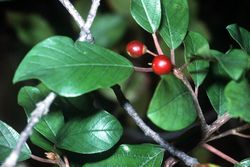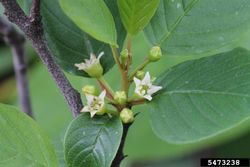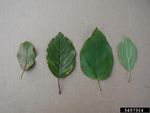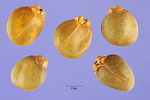Glossy buckthorn
| Glossy buckthorn |
|---|

|
| Scientific Classification |
|
| Scientific Name |
|
Frangula alnus |
| The flower of a Glossy Buckthorn |
The Glossy buckthorn is a type of shrub that is known by the scientific name Frangula Alnus. They are an invasive species that was introduced from Eurasia and can be recognized if you take a close look at it. It might have came from a shipping of ornamental plants from Europe to Minnesota and the buckthorn plants were in the cargo. It spread to multiple states since then. It is considered as an invasive species because it takes over the forest it is in if not taken care of. There are ways that you could keep it under control for the time being but there are no known ways of taking care of it for good.
Body Design
The glossy buckthorn is a large shrub growing up to twenty feet or more, but a normal shrub could only grow to six feet. It's leaves are oval shape, has nine pairs of veins and has smooth margins as seen in the pictures on the left.[2]. It has a brown bark which is a pretty common color for shrubs, what's make this tree a bit more unique is that it's inner bark is yellow. It also has small white flowers that blooms during May to September although the flower is beautiful and it also reproduce berries that can be used for food, there are much more beautiful shrubs in the wild [3].
Life cycle and Ecology
The Glossy Buckthorn starts off as a seed and it could grow up to a giant perennial deciduous shrub. As soon as it's able to reproduce fruit it can spread very easily because the birds or other animals could just eat the fruit and spread the seeds through out the forest by eating the seeds and carrying them all over the forest. It has a pretty normal life cycle as any shrub would but it can takes over forests at a fast rate. It is also serves as a food source for birds which is rather rare because shrubs having flowers are normal but having fruit is a very different story. It affects the ecology a lot because of it's invasive traits, it takes over forest very easily because they have no predator that could take them out and they also spread very easily which is a deadly combo because if there weren't any man help the native species that live in the same habitat as the glossy buckthorn would have disappeared due to no control [4].
Invasive Species
Location and Method of Introduction
The Glossy Buckthorn was native to Eurasia and was introduced to Europe and America as an ornamental decoration. It is not considered as a pest or a risk in it's native range, it's only an annoying pest in America. They degenerate the habitat that they are in by taking all of the essentials of the plants that live in the same habitat as them such as light and moisture. It could have been introduced to America in the eighteen hundreds through Eurasia when a lot of kinds of ornamental were introduced, with many kinds of buckthorn in those ornamental. Now they have spread to multiple states, they are very harmful to our forest so we must keep them under control if we don't want out forest to be covered with glossy buckthorns [5].
Environmental Impact'
The glossy buckthorn is a dangerous invasive species because they spread very easily through birds carrying the seeds, they take over forest by covering the forest with glossy buckthorns shrubs and taking all the surrounding plants that is in the same forest it's light, moisture and other essentials. They can easily spread so if we didn't take care of them when they started to populate their would have been a lot of forest that is only covered with glossy buckthorns or with overgrown vegetation made of glossy buckthorns but luckily we are able to control of them for now. A lot of native plants would have been wipe out by now if we didn't control it [6].
Control Methods
It can be controlled both manually or chemically. Doing it manually is a lot more inefficient and is more recommended of taking out small scale areas by pulling out the small saplings before they reach maturity and it's easier to get rid of them before they grow to full size and we would have to use more force by cutting down the tree would take a lot more time and effort. Although this method won't stop them from regrowing but it will slow down their process of growing. They also have no herbivores to take them down so we must reside to using herbicides such as using Tryclopyr to slow down the growing process. Another way is to burn the tree down but it is not recommended because it could cause wild fires if not careful. There are no permanent method to get rid of them or properly keep them check for good without keep going back to check up on it, all we have now is to continually keep them in check but hopefully there will be some method in the future to keep them in order for good and we won't have to expense money every year to keep them in check [7].
Video
How to identify Glossy Buckthorn
References
- ↑ Frangula alnus USDA. Last visited May 21,2017. Unknown author
- ↑ Buckthorn Identification Department of natural sources. Last visited May 21,2017. Unknown author
- ↑ Glossy Buckthorn Michigan department of agriculture. Last visited May 21,2017. Unknown author
- ↑ Glossy Buckthorn Forest invasive plants resource center. Last visited May 21,2017. Unknown author
- ↑ Buckthorn Department of natural resources. Last visited May 21,2017. Unknown author
- ↑ Glossy Buckthorn IPSAWG. Last visited May 21,2017. Unknown author
- ↑ Buckthorn Department of natural resources. Last visited May 21,2017. Unknown author



